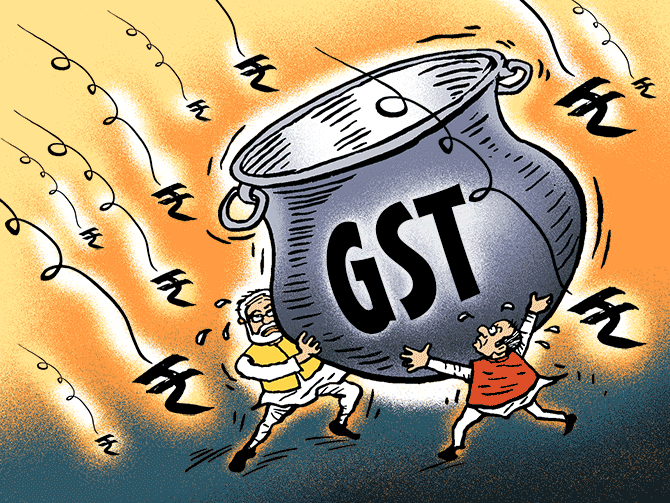The confidence that GST Network is capable of handling the returns, payments, reconciliation, refunds, etc., has been badly shaken.
Illustration: Dominic Xavier/Rediff.com

When the Goods and Services Tax (GST) regime was introduced on July 1, 2017, a major apprehension was that the trade and industry was not well prepared.
As it turns out, it is the government that is not well-prepared for implementing the indirect tax system.
First, exporters had no clear guidelines on how they can send their goods abroad. The Central Board of Excise (CBEC) came out with one clarification after another till six weeks after the new laws came into effect.
There are many issues relating to supplies to Special Economic Zones (SEZ) units and developers that have still not been addressed.
For example, whether a bill of export needs to be filed even when no incentives are being claimed; how to procure minor services like that of electrician, carpenter, plumber when they are not registered; how SEZ developers can pay in foreign currency for services supplied against a letter of undertaking and so on.
In the meantime, some laws have been amended and tax rates have been changed in response to various representations.
Initially, the main concern of the trade and industry was to get the classification, tax rates and manner of invoicing right.
On August 8, the government specified August 20 as the last date for filing summary returns of outward and inward returns for July and payment of tax for July, without taking into account the carry-over of credit balances from the earlier regime.
The government resolved this problem just two days before the deadline. But by then, many had filed their returns and paid their taxes, blocking their working capital.
As the cut-off date neared, the GST Network could not take the load and the closing date was extended.
To be fair, the GST laws were put into place after considerable discussions with stakeholders.
The government answered many questions from the trade through tweets, circulars, advertisements in print media and its websites, although some of these replies are incorrect.
It conducted many outreach programmes to increase awareness. Still, many exporters had to cope with wrong trade notices issued by the Customs department calling for incorrect declarations for drawback claims and are uncertain about getting their claims and fear unexpected tax liabilities.
The confidence that GST Network is capable of handling the returns, payments, reconciliation, refunds, etc., has been badly shaken. Much depends on how it handles the workload in the coming months.
In a tax reform of such great sweep as the GST, it was always expected that there would be some glitches at the initial stages.
However, it was not expected that there would be unnecessary six weeks’ delay in prescribing export procedures or incorrect trade notices or the inability to put in place systems for carryover of the credit from the earlier regime or lack of preparedness to cope with the rush to pay the taxes just before the deadline or the absence of answers to questions raised by SEZ units and developers and so on.
The government must understand that elements in the trade who were unprepared hurt themselves, whereas lack of preparedness on its part has wounded everyone.
Industry carried on with the problems because it has no choice but the costs are enormous.
The effects are bound to show up in the coming months.











